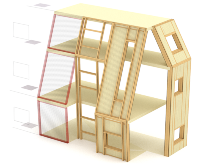MONO-MATERIAL WOOD WALL
Leveraging computational design and digital fabrication to improve the building physics performance and production efficiency of a solid timber building envelope
This research seeks to understand the factors that impact the development of a low-carbon footprint building envelope that can replace steel and concrete in multi-story construction to enable further expansion of housing stock and the built environment while minimizing negative environmental impact. The general strategy is to use solid timber to achieve all main structural and building physics requirements without adhesives, metal fasteners or other artificial material layers. This research follows on the success of a previous ZukunftBau project, called Baukonstruktionen aus Massivholz (10.08.18.7-15.59), which utilized digital fabrication to improve thermal insulation and airtightness of the envelope while simultaneously expanding the formal capabilities of the system. A core focus of the project was a standard timber element, which features deep slits sawn in the profile to improve the thermal insulation performance of the envelope.
This research begins with the timber profile developed in the previous research and seeks to understand the factors that impact its performance with the goal of increasing sustainability and reducing production cost. The parameters of the timber profile are investigated to allow further improvements to energy performance. Building physics analyses seek to increase longevity and occupant safety characteristics to meet forward-looking building standards. The timber joints are investigated to understand their potential in a multi-story, urban, application. Fabrication efficiency is investigated to understand the route to cost-effective industrial production.
Research is conducted under a structure of four work packages that address individual aspects of the research or significant steps in the development and analysis process:
- Profile development seeks to make the required changes to the timber profile and other timber construction elements to enable improvements in building physics and the expansion of application for multi-story use.
- Production optimization is primarily concerned with increasing the production speed of the enhanced building physics timber profile. The other primary focus is on digital workflows that empower various actors in the design, engineering and construction industry to collaborate and quickly design, analyze and machine and assemble the envelope system.
- Fabrication is required to test the developments in both profile development and production optimization phases. Small samples, medium scale prototypes, and a full-scale mock-up are to be fabricated and assembled to evaluate production and assembly processes and then to be used in laboratory tests of various building physics criteria relevant to energy performance and occupant safety.
- Analysis to give concrete numbers to benchmark the proposed improvements. These include standard tabulations, simulations, and physical testing.
Research results elucidate the impact of system details and production processes in terms of building physics performance and production speed. New tectonic strategies enabled mid-grade structural spruce assemblies to bear 5 stories of vertical load, including after the required fire-protection duration of 60 minutes. New insights into the insulating effect of air layers allowed thermal transmittance to be reduced to U=0.18W/m²K, with thermal resistance values up to 21 percent higher than norm-based values. Airtightness varied widely between samples, and the system had an air permeability flow rate between 1.39 and 2.68. Simulation and laboratory tests also showed that solid timber has robust hygrothermal behavior that should resist deterioration from moisture accumulation. Custom machining tools showed the path to improved production times, with speeds increased by a factor of 10 from the preceding project, and new digital tools show new potential workflows for rapid design iteration, analysis, and production, with the system.
Ultimately, the research demonstrates methods that can be used to achieve improved energy performance with solid timber while maintaining a negative global warming footprint due to carbon sequestration, but also shows the difficulty of getting consistent performance with the unpredictable, heterogeneous, construction material, wood.
PROJECT TEAM
ICD Institute for Computational Design and Construction, University of Stuttgart
Oliver Bucklin, Prof. A. Menges
PROJECT FUNDING
German Research Foundation (DFG), EXC 2120 IntCDC
BBSR ZukunftBau
RELATED PUBLICATIONS
Bucklin, O., Müller, T., Amtsberg, F., Menges, A.: 2023, Analysis of Thermal Transmittance, Air Permeability, and Hygrothermal Behavior of a Solid Timber Building Envelope. SSRN, preprint. (DOI: 10.2139/ssrn.4476392 )
Bucklin, O., Di Bari, R., Amtsberg, F., Menges, A.: 2022, Environmental Impact of a Mono-Material Timber Building Envelope with Enhanced Energy Performance. Sustainability, 15(1), 556. (DOI: 10.3390/su15010556)
Bucklin, O., Menges, A., Amtsberg, F., Drexler, H., Rohr, A., Krieg, O. D.: 2022, Mono-material wood wall: Novel building envelope using subtractive manufacturing of timber profiles to improve thermal performance and airtightness of solid wood construction. Energy and Buildings, 254. (DOI: 10.1016/j.enbuild.2021.111597)
Contact Information

Oliver A. Bucklin
M.Arch, BFAResearch Associate, Doctoral Candidate


